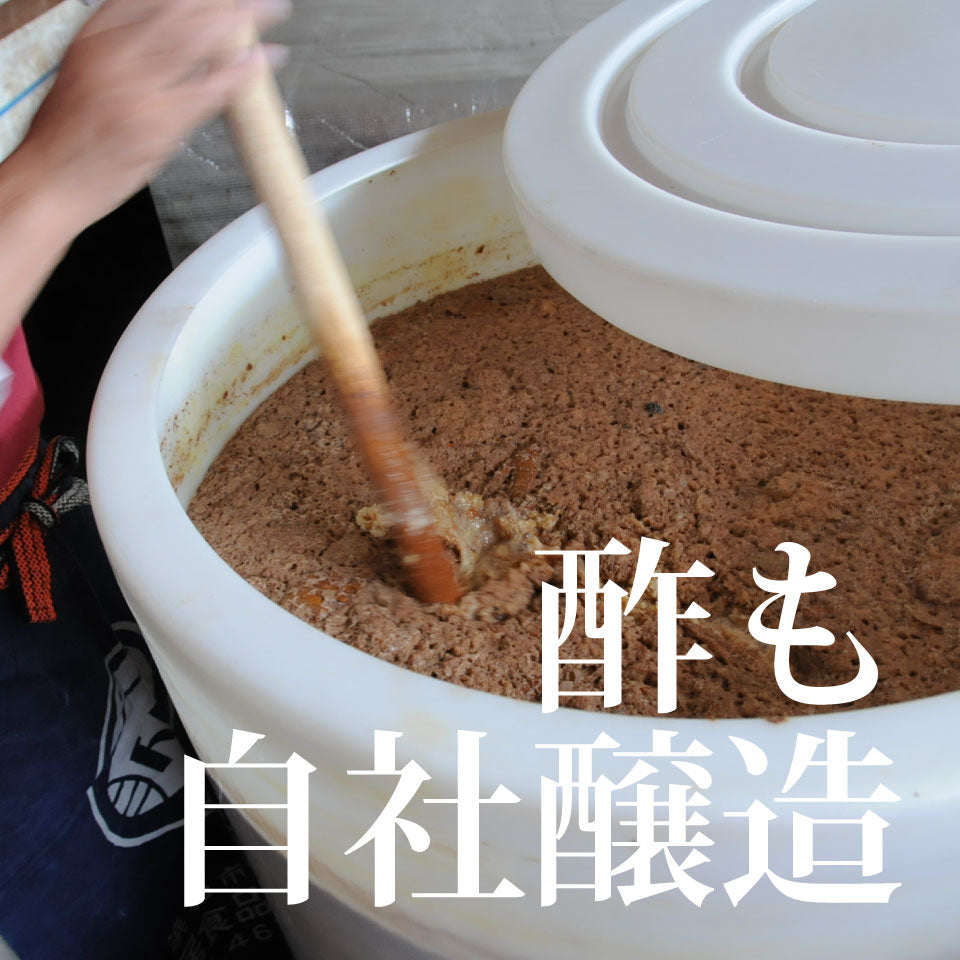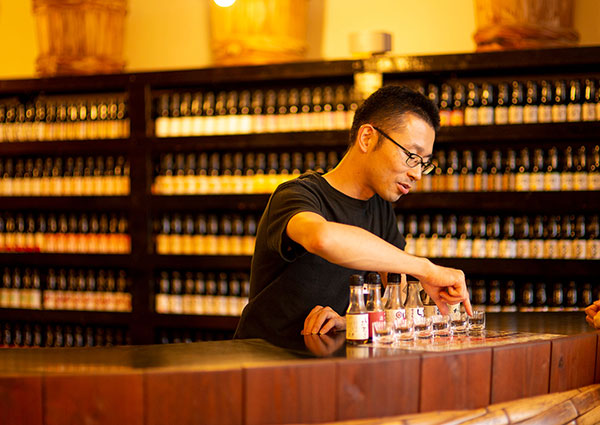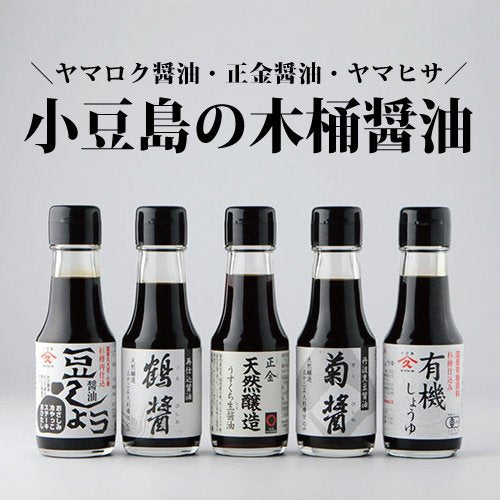













Worcestershire sauce (Torii sauce)
Worcestershire sauce made in a wooden barrel
Shokunin Shoyu No. 3094

A sauce shop in Kakegawa, Shizuoka that has been in business for 100 years
"It has to be this sauce" - you can almost hear this sentiment expressed by a local who continues to love the sauce. Torii Sauce, located in Kakegawa City, Shizuoka Prefecture, is a long-established sauce manufacturer founded in 1924.
The main ingredients of a dish are vegetables, meat, and fish, and condiments are considered to be supporting ingredients that enhance the flavor of the main ingredients.Their aim is to create sauces that are not just "delicious" on their own, but that are delicious when combined with the food.
The ingredients of the sauce are surprisingly unknown. President Torii Daisuke explains, "Soy sauce adds saltiness and umami, while sauce adds sourness and umami." The source of sourness is vinegar, and the source of umami is vegetables. Adding spices to these makes the sauce.
Torii Sauce's sauces are made by slowly simmering 100% domestically produced vegetables and fruits, and are characterized by their deep richness and gentle sweetness. They continue to adhere to a manufacturing method that does not use food additives and values the natural flavor of the ingredients.
Torii Sauce's Commitment
1. Whole raw vegetables
The first time I tried Torii Sauce, I thought, "Hmm, it's kind of mild..." And it turns out it's because they simmer whole, skin-on, domestically grown vegetables, including carrots, onions, tomatoes, and even celery. And they use real vegetables, not powders or concentrates. Perhaps that's why it has a smooth texture and a refreshing aftertaste.
When you think of sauce, you might imagine something "strongly seasoned," but Torii sauce doesn't get in the way of the food, but rather enhances it. It has a gentleness that makes you think, "This is the first time I've ever tried a sauce like this." I think this is what makes Torii so great.

2. In-house brewed vinegar
Vinegar is a great supporting actor that brings out the flavor of the sauce.
Torii Sauce even makes their own vinegar in-house. They use domestically produced rice and sake lees, which are left to ferment slowly and carefully using the traditional static fermentation method. Fermentation and aging takes time, but this results in a smooth, rounded, and acidic taste.
Many people probably don't pay much attention to the vinegar in sauces, but I really love the sourness of this sauce. It's not too sharp, but it brings the flavors together nicely, making it a great supporting actor.

3. Original spices
Speaking of sauces, spices are essential. It is common to grind spices into powder and add them to the sauce, so that the aroma of the spices can be efficiently absorbed into the sauce.
However, at Torii Sauce, the spices are placed in a strainer bag in their original form (or coarsely ground) and then soaked in the sauce. This is to ensure that only the aroma is dissolved into the sauce, and that the bitterness does not interfere with the flavor. What's even more amazing is that the soaking temperature is divided into two stages. There are spices that can withstand heat and spices that can't, and this is apparently to ensure that only the desired aroma is thoroughly dissolved.
The idea is to put spices in a bag and steep them, but Torii explained, "It might be easier to understand if you imagine tea brewed in a teapot and powdered tea. Tea brewed in a teapot has less impact, but it goes down smoothly. Powdered tea has a straightforward taste, but still retains a bitter aftertaste."
It's amazing how much care and attention they put into it! I think that effort really shows in the flavor. The aroma of the spices is strong, but not at all cloying, and it has depth without any unpleasant aftertaste, yet is gentle.

4. Maturing in wooden barrels
Torii Sauce simmers Worcestershire sauce and ages it in wooden barrels. Isn't it a bit shocking to know that a sauce factory has wooden barrels?
The sauce is aged in wooden barrels to even out the flavor and concentrate the umami flavors passed down through generations. While aging can make the flavor more rounded, if the saltiness is too even, the flavor becomes dull. Torii Sauce has used its many years of experience to find the perfect balance between aging for about a month.
Many of Shokunin Soy Sauce's customers are very impressed with the wooden barrels. Sauces brewed in wooden barrels are extremely valuable!!




The key to the flavor is the extra step of simmering the vegetables
The first impression is that it is a light and refreshing Worcestershire sauce with a pleasant acidity. Torii's Worcestershire sauce is made with plenty of grated domestically grown fresh vegetables, such as carrots, onions, tomatoes, and celery. These are slowly simmered and finished with spices to create a base that is rich in aroma and body. The smooth texture is rich in the umami of the vegetables, the gentle sweetness, and the aroma of the spices.

Recommended for soy sauce lovers
Actually, I'm not a sauce person, I'm a soy sauce person. Soy sauce is a standard for fried foods as well as fried eggs. However, this Worcestershire sauce is a little different. I think this might be okay.
I looked into the reason and found that the sauce base is made with kelp and bonito stock! "The unique flavor of Torii Sauce, made with Japanese ingredients, is probably the reason why it is accepted by soy sauce lovers as well," according to the Torii Sauce website. So true!! It makes me happy to think that there are so many people who feel the same way as me.

Torii's Worcestershire is not just for baking!
When you think of regular Worcestershire sauce, many people think of it as something to put on pork cutlets or croquettes, but Torii's Worcestershire sauce is different. It's also an excellent seasoning. When used in stews or stir-fries, it adds depth to the flavor of the dish. Because it's not a punchy-flavored sauce, it's easy to use in everyday cooking.
・To season stir-fried vegetables ・As a secret ingredient in meat sauce ・To add richness to curry or beef stew ・For meat and potato stew with sauce

\Recommended for these people/
・People who feel that commercially available Worcestershire sauce is "a little too strong" ・People who want to bring out the flavor of ingredients without relying on chemical seasonings ・Cooking enthusiasts who want to use sauce beyond the framework of something that is simply poured on top

If you are interested, please read this too↓
What's the difference between Torii Sauce's Worcestershire and Chuno sauces? Both are additive-free sauces made with plenty of domestically grown vegetables and painstakingly crafted. But once you try them, you'll be surprised at how different they are.
◎Worcestershire sauce is for when you want to "blend"
Worcestershire is light and smooth with a moderate spice aroma. When used in stir-fried vegetables or yakisoba, it blends seamlessly with the ingredients and brings together the flavors. It is easier to use as a seasoning, adding a little extra flavor or adding richness to stews.
◎Medium-thick sauce is for when you want to add it to complete the flavor.
The medium-thick sake is smooth and creamy, packed with the sweetness of vegetables and fruit. When poured over pork cutlets, croquettes, omelets, etc., it has a rich flavor that completes the dish. If you're looking for a "standard" sake for your family dinner table, start with the medium-thick sake. Its gentleness makes it easy for both children and adults to eat, and it's appealing that it's gentle on food.
Recommended usage
| scene | Which one is perfect? | The reason |
| For stir-fried or stewed vegetables |
Worcester |
Lightweight and adapts to the material |
| For tonkatsu and croquettes | Nakano | Thick and rich flavor |
|
For omelets and hamburgers |
Medium-thick Worcestershire to your liking | Achieves both sweetness and aroma |
|
A secret ingredient in curry |
Worcester | The spice is exquisitely effective |
Text: Miho Matano (Shokunin Soy Sauce)
Choose options









































